For a long time I was an exclusive user of hardbodied lures when targeting Murray cod. The rest of the world seemed to be using spinnerbaits while I found it too hard to step away from the lures that had served me well for so many years to explore something new.
Then a couple of years ago, my good mate Adam Bosley kindly handed me half a dozen of his home made spinnerbaits as a token of his appreciation of me for feeding his cat. After that I decided to give one a go, and I am glad I did as I had almost instant success which built my confidence in spinnerbaits, and killed off my fear of the unknown.
Although I like to use spinnerbaits a lot more often these days, I am still a diehard fan of hardbodied lures. When it comes to Murray cod fishing nothing intimidates a fish into a strike like a very large 140mm or 150mm hardbodied lure. Some of these ultra-large lures can dive to depths of between 12-15m, crashing through the logs and hidey holes of the aggressive Murray cod as they lay in ambush.
Murray cod will usually hit the hardbodied lures for one of two reasons: they are hungry and want to eat the lure or they are aggressive, territorial fish and want to kill the lure. This is where the ultra-large lures come into their own because they intimidate the larger, more aggressive cod. In the winter months as the cod begin to prepare for the spring spawning season they will attack the larger lures more readily.
The best ways to fish these ultra-large lures in search of an aggressive strike is to continually pepper the same area over and over again. If you are trolling a nice section of river, troll through it, then turn around and troll through it again and continue this process and eventually a large Murray cod may just crack it and give your lure a pounding and your heart an irregular beat.
When the Murray cod are active, mainly during the warmer months they are more likely to hit your lure out of hunger rather than aggression. I find the smaller lures to be a bit more productive. When I say smaller lures, I am still referring to large lures of around the 100mm size or thereabouts.
When casting lures from a kayak, boat or bank, hardbodied lures around the 80-100mm size are ideal for Murray cod. The ultra-large lures as mentioned earlier are not very good for casting unless you have a very stiff rod as they are so heavy. Having said that, I do cast them from my kayak, but I cast them slowly and cautiously and never had any problems.
When drifting down a river in my kayak with quite a large area of water to cover I find the hardbodied lures are the best because I do not have to waste any time waiting for them to sink, I just cast them out and immediately retrieve them. There are times however, where my cast may fall short of the intended snag pile or structure, and when this happens I will allow the lure to float on the surface and drift as closely as possible to the structure before beginning to retrieve it.
Quite often, when doing this the lure will get smashed off the surface by a hungry Murray cod.
Speaking of Murray cod on the surface.
Surface luring for Murray cod is rapidly growing in popularity. It is not as productive as diving hardbodied lures due to the poor hook up rates and the fact that it is best done at the low light periods of the day, or during the night, however it is an extremely exciting form of fishing for those willing to stay out late.
There are quite a few DVDs out these days, such as the recently released “Working the Surface” DVD which walks you through how to use surface lures effectively for Murray cod.
The best way to work hardbodied surface lures, commonly known as a surface popper or just popper is to cast it out in the direction of a snag pile, or close to the bank, then retrieve it as you would a diving lure. The popper will go plop, plop, plop, plop across the water’s surface, sending vibrations through the water and leaving a bubble trail in its wake, especially in calm, smooth water.
Everything will be quiet and peaceful, you will be admiring the sunset, or the stars and your mind will be miles away when ‘BOOOOOM” a Murray cod hits your surface popper with lightning speed creating a loud bang as it breaks the waters smooth surface and its tail slaps the surface as it turns and makes its way back towards it’s snag, hopefully with your lure still in its mouth.
When a cod does hit your surface popper, the best thing you can do is refrain from striking. Just hold your rod until you can ascertain whether the fish is hooked or not. By striking to set the hooks, more often than not you will pull the lure straight out of the fishes mouth, and because the lure is only just under the water’s surface the lure will fly out of the water and in your direction which not only creates an obvious hazard, but also takes the lure out of the strike zone.
If, after the original strike you realise the fish is hooked then you proceed to reel it in, if you realise it is not hooked you do not wind the lure in. The best thing to do is just leave it sitting where the fish hit it.
I usually allow 10-15 seconds for the fish to come back for a second attempt, which very often happens. If the fish does not come back, I twitch the popper a bit to send out a few ripples and vibrations, making it look like it is wounded in an attempt to lure the hungry fish back out.
If this still does not work, I then continue on with my retrieve, then cast back out to the exact same spot and try again, quite often an individual fish will come back and hit the lure 5 or 6 times before either finally hooking up or giving up.
It is always good to have a second rod rigged with a spinnerbait, that way if the fish stops hitting your surface lure you can cast a spinnerbait and retrieve it not far under the surface and more often than not the now cautious fish will hit that instead.
Speaking of spinnerbaits.
The first, and most obvious advantage of using a spinnerbait instead of a hardbodied lure is that it sinks, and can be fished vertically. For example, if I am in a boat casting lures against a steep bank where it is 2.5m deep, I can let the spinnerbait sink all the way to the bottom and begin my retrieve hard up against the bank and the snags, where the fish are.
With a hardbodied lure, if I cast it into the same spot, I need to retrieve it to make it dive and by the time it dives to around 2.5m it is a long way from the bank and half way back to the boat. In saying that though, the cod are not always sitting on the bottom, quite often they are not far under the water’s surface, we just never see them because they camouflage so well.
For those cod that are sitting up higher in the water column, they will not allow the spinnerbait to sink past them as they watch hopelessly, they will certainly hit that spinnerbait as it is sinking, or ‘on the drop’.
The times where I am most likely to tie on a spinnerbait are when I have a smaller area to fish, where I am really peppering a short distance and have got plenty of time to allow the spinnerbait to sink into every nook and cranny and thoroughly work the water.
Also, when casting into deep holes where I cannot get hardbodied lures down to the depth I want. Another spot they come in handy is when I am fishing ultra-clear water, like the upland sections of some of the rivers where water clarity is amazingly clear, sometimes water visibility can be 3-4m and the cod do not like to come out into the open. By using a spinnerbait I can cast very tightly into the shady corners of holes and allow the lure to sink right down into the tight dark corners.
One tip I will give with casting spinnerbaits, is to retrieve them as slowly as possible. They do not need to be retrieved quickly. I like to let mine sink and then retrieve it very slowly keeping it down deep for most of the way in.
Usually known as buzz baits, these surface spinnerbaits are a lot of fun. They need to be retrieved quicker than a normal hardbodied surface popper to prevent them from sinking, and if you miss the fish you have to just keep winding because they do not float. Buzz baits are also an exciting form of Murray cod fishing, and the revolving blade of a buzz bait sounds like a propeller as it skims across the water’s surface attracting Murray cod. Buzz baits offer the exact same type of excitement as surface poppers, the only difference is that they sink so cannot be left floating waiting for a second strike.
Reads: 32529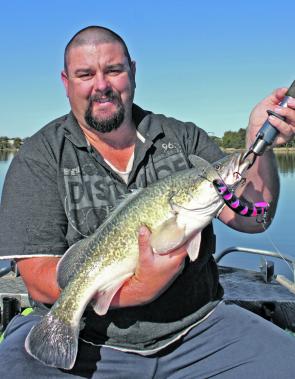
Don’t be afraid to use very large lures, especially in the cooler months. This 60cm cod fell to a 150mm JD Superbug being trolled in the submerged river course at lake Mulwala.
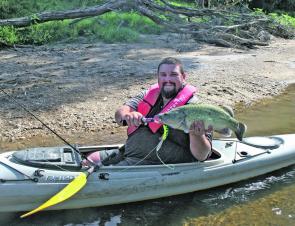
A Murray cod caught casting an 85mm JD superbug from the author’s kayak. On this particular day we had around 20km of river to cover, so hardbodied lures were used for the entire day because they are quicker to fish when you are drifting.
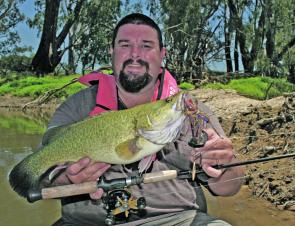
A young Murray cod caught close to the bank casting a Mudguts spinnerbait.
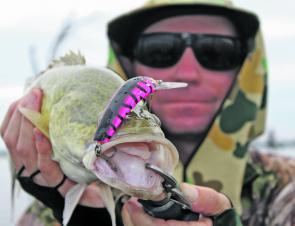
This small Murray cod fell to a more average-sized Predator hardbodied lure.

Pre-dawn, a great time of day to cast surface poppers and buzz baits around.
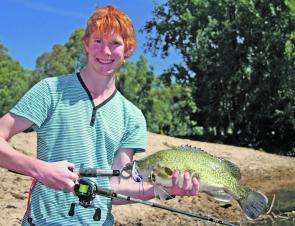
Jeremy De Haan with a nice Murray caught casting an Ausspin spinnerbait.

Cold autumn mornings are perfect times for casting surface poppers and buzz baits around.

Brenton Richardson with a lovely coloured small Murray cod caught in clear water on a Mudguts spinnerbait.
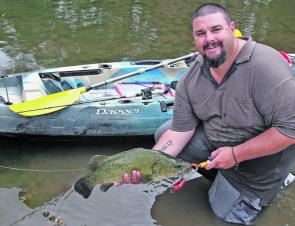
The author with a nice coloured 61cm Murray cod caught casting an 85mm JD Superbug. This fish actually took the lure off the surface as it was drifting towards a snag pile.
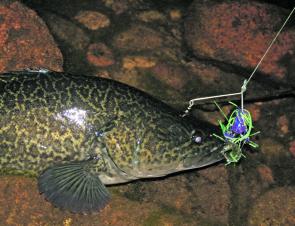
A nice clear water Murray cod taken on a small 3/8oz Mudguts spinnerbaits. Smaller spinnerbaits of this size are popular lures for yellowbelly, but also work well on Murray cod.
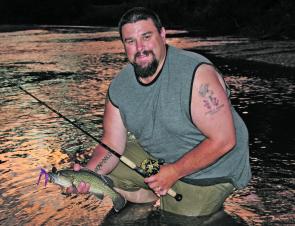
The author with a small protected trout cod. This fish fell to a 3/8oz Mudguts spinnerbait while targeting Murray cod and was released as soon as this photo was taken.




